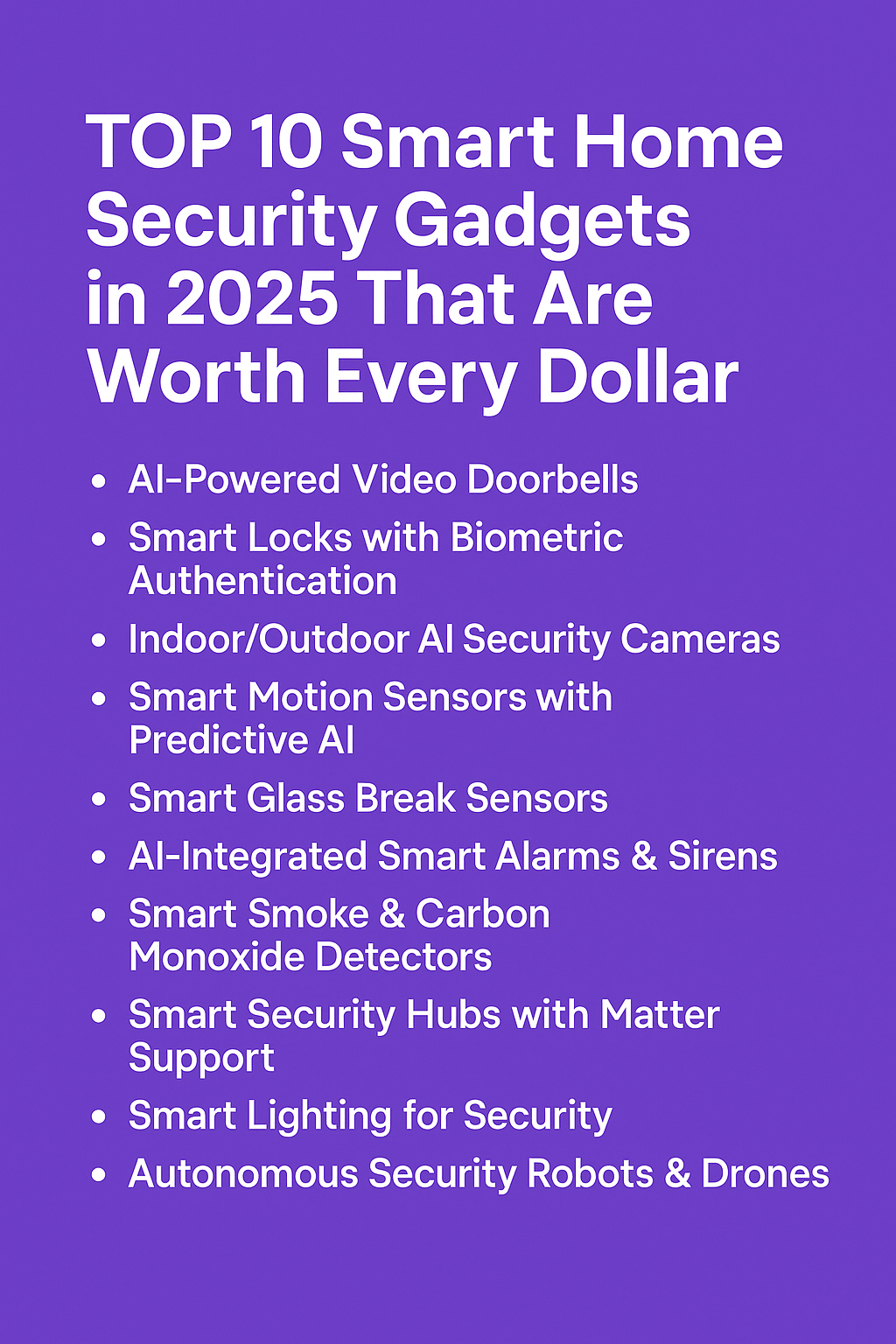Welcome! Check out our latest news.
HOT DEALS
Smart home technology continues to evolve rapidly in 2025. If you're investing in making your house smarter, more efficient, safer, and comfortable these 10 gadgets represent some of the best value out there. Each delivers strong features, integration, or innovation that make the purchase worthwhile. Whether you’re after convenience, security, automation, or just fun, one or more of these may fit your needs.
1. Matter-Compliant Smart Hubs & Bridges
Why it’s essential:
Interoperability has long been a headache in smart homes: different ecosystems (Apple HomeKit, Google Home, Amazon Alexa, etc.), different protocols (Zigbee, Z-Wave, proprietary), confusion over which devices talk to which. The Matter standard, now stabilized in version 1.4.2 as of August 2025, aims to unify many of these under IP, Thread, Wi-Fi, etc., reducing friction in setup, security, and extension.
What to look for:
Value for money:
Buying a Matter-compliant hub or bridge may seem like overkill now if your current devices already work, but in the medium term it prevents you from having to replace devices or bridges. For households planning expansion (sensors, smart plugs, lighting), it can save dozens or even hundreds of dollars and hours of frustration.
2. Advanced Robot Vacuums / Mop Combos
What’s new in 2025:
Robot vacuums have stepped up in terms of mapping, obstacle-avoidance, self-emptying / mop self-washing, and even edge-cleaning capability. The Dreame X50 Ultra Complete is one such model: high suction (~20,000 Pa), mop pads that adapt to carpets, automated self-cleaning/drying docks.
Also, Vacuum Wars’ Top 20 list confirms several robot vacuums with full auto-maintenance like mop washing / pad drying and self-empty docks.
Why is it worth it?
Things to watch out for:
Battery life, especially on large square footage homes; noise; size/clearance under furniture or thresholds; upkeep of mop systems (pads, water, etc.).
3. Smart Thermostats (Entry & Premium Options)
What’s changing:
Lower-cost models with full-color touchscreens and cross-ecosystem compatibility are becoming more common. For example, Ecobee’s Smart Thermostat Essential (2025) is designed to compete in pricing with the Nest Thermostat, offering many key features.
Smart thermostats continue to deliver energy savings, better comfort, and deeper integration with home automation (room sensors, remote control, scheduling).
Value proposition:
Even if the upfront cost is higher, most homes can recover via energy savings (heating & cooling) within a few years. Also, better control, learning algorithms, occupancy detection, etc., improve comfort.
4. Smart Lighting Ecosystems & Motion-Aware Devices
Trends in 2025:
At IFA 2025 for example, Philips Hue launched its largest product refresh: a new video doorbell, an overhauled Hue Bridge Pro (supporting more lights, more accessories), and motion-aware lighting (lights acting as their own motion sensors) via Hue Motion Aware. Also, more affordable Matter-over-Thread bulbs are entering the market.
Why it’s compelling:
5. Smart Water Purifiers / Smart Kitchen Appliances
What’s happening:
Samsung launched a Bespoke AI Water Purifier in South Korea (~US$1,000), which uses AI, voice control (Bixby), app integration, and self-sterilization.
More generally, the “smart kitchen” trend is stronger: fridges that track inventory and suggest recipes, ovens with automatic cooking profiles, etc.
Why worth the cost:
6. AI-Enabled Wearables / Smart Glasses
New entries:
Meta’s Ray-Ban Display glasses, Oakley’s Meta Vanguard, Ray-Ban Gen 2 (with improved battery, cameras) feature AI-driven capabilities: notifications, gesture controls, live translation, etc.
Why some users find them worth it:
Caveats:
Battery life, privacy concerns (camera/mic), cost; best for early adopters or people who will actually use the features regularly.
7. Smart Home Security: Cameras, Locks, Doorbells
What to expect in 2025:
Better AI detection for distinguishing people vs pet’s vs objects; more local processing to preserve privacy; integration with standard protocols. Also, video doorbells and locks are more robust, tamper-resistant, and more integrated into ecosystems. Engadget’s “Best Smart Home Gadgets for 2025” includes improved video doorbells and security camera solutions.
Return on investment:
8. Climate & Air Quality Sensors & Purifiers
Why it’s more relevant than ever:
With concerns about indoor air pollution, wildfire smoke, allergens, etc., devices that measure VOCs (volatile organic compounds), CO₂, humidity, and act (purify, ventilate) are high priority. Also, regulators and building standards increasingly expect better ventilation. Trend reports cite “energy-efficient smart appliances” and “sensors for environmental control” as key.
What to pick:
9. Smart Display / Voice-Assistant Hubs
Evolution:
Smart displays are no longer just about showing weather or video calls. Newer models include bigger screens, better voice assistant responsiveness, higher-quality speakers, better integration with hubs/dashboards for entire smart home control. TechRadar’s guide includes updated smart displays (e.g. Google Pixel Tablet, Alexa 15 etc.).
Why people love them?
10. Autonomous Robots Beyond Vacuuming
Recent developments in the space:
Innovations showcased at CES and IFA feature robots with capabilities extending beyond basic cleaning. These include pet-camera hybrid models, robots designed to project information or serve as mobile hubs, and advanced devices such as Samsung’s Ballie, which can autonomously follow users, manage other smart devices, and display workout data.
Value points:
How to Choose Smart Gadgets That Actually Deliver Value
To make sure your investment is worth every dollar, consider these criteria:
Why These Gadgets Are “Worth Every Dollar”
What’s Coming Next
Looking ahead, several trends are likely to increase ROI of smart home gadgets:
References
Consumer Reports. (2025). Best thermostat buying guide. https://www.consumerreports.org/appliances/thermostats/buying-guide/(Consumer Reports)
The AC Guy. (2025, April 3). Is a smart thermostat still worth it in 2025?(the-ac-guy.com)
TechRadar. (2025). Dreame X50 Ultra Complete review. (TechRadar)
Vacuum Wars. (2025). Top 20 Best Robot Vacuums in 2025. (Vacuum Wars)
The Verge. (2025, January). Ecobee launches an even cheaper smart thermostat. (The Verge)
News sources from IFA 2025 about lighting & Hue release: Philips Hue launches new products at IFA. (2025) (The Verge)
Samsung. (2025). Bespoke AI Water Purifier announcement. (Tom's Guide)
Meta Connect 2025. Ray-Ban Meta, Oakley, and smart glasses news. (TechRadar)